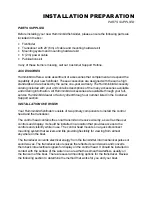
6
INTERFERENCE REJECTION EXPLAINED
The purpose of interference rejection is to reduce cross-talk interference from other nearby depth sounders. This can be very helpful if you have
another sounder mounted on your boat running at the same frequency as your flasher. It is also helpful when nearby anglers are running sounders
operating at the same frequency as your flasher.
Cross-talk interference occurs when the signals sent from one depth sounder are received by another. If the two sounders’ frequencies are the
same, each unit is unable to differentiate between its own signals and others. What you see as interference is actually the signals of the other
sounder displayed on your screen. The signals can circle around the display
or remain stable. Beware of the stationary interference signals. They can
lead you to believe the depth is different than it is, or that there’s a fish
hanging below you which isn’t really there.
Usually, when you see interference on one sounder, the other sounder will
show it too. Therefore, when you use your Interference Rejection to reduce
or eliminate the interference on your display, the other sounder will see
a similar reduction. This means you can use your Vexilar flasher next to
another sounder which does not have the IR feature and both sounders can
run more clearly.
If two Vexilar units are operating together, you will get the best results
by leaving the IR setting at one level on one unit, while adjusting out the
interference displayed on both units using the second unit’s IR feature.
Interference occurs when the cone angles of two separate sounders
operating at the same frequency intersect. It can also occur if the
sonar signal from one sounder bounces off an underwater object and is
received by another sounder.
Содержание FL-18
Страница 2: ......






























